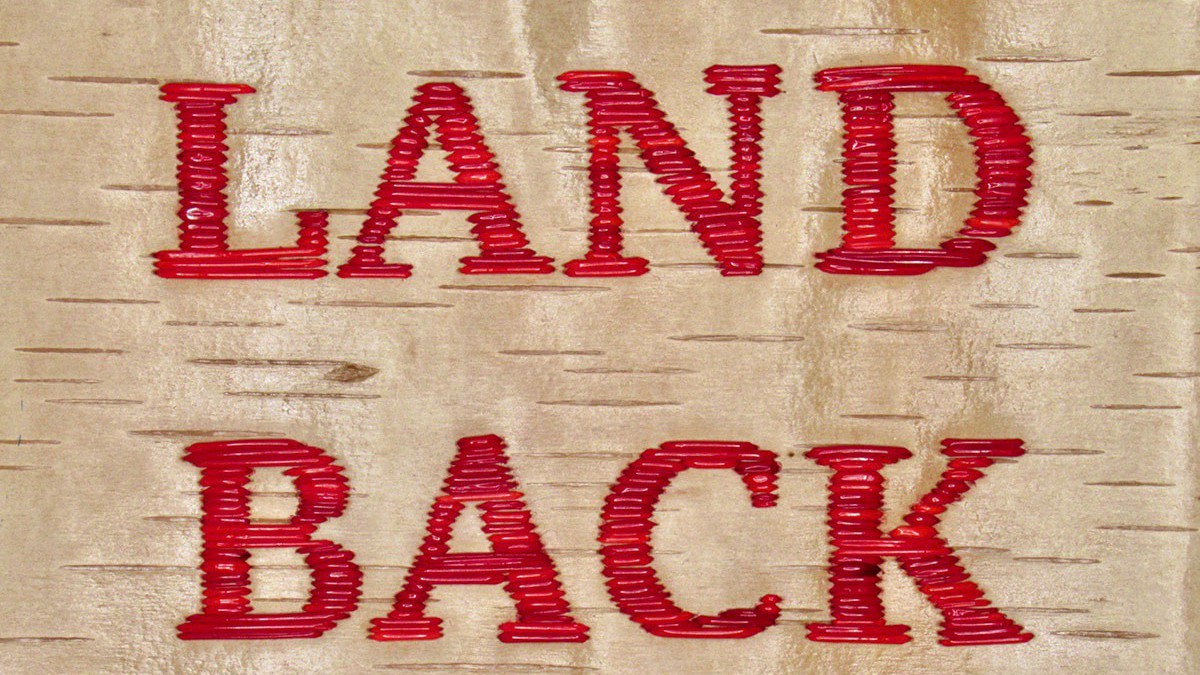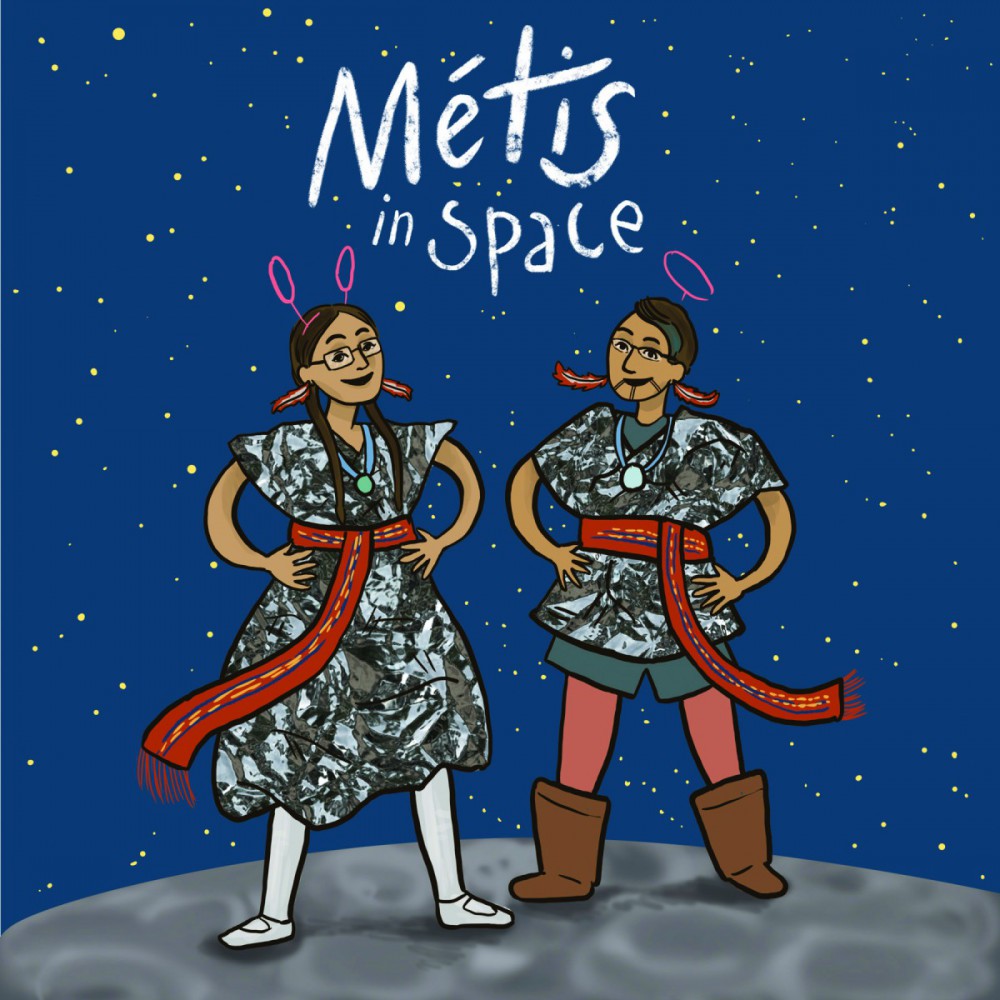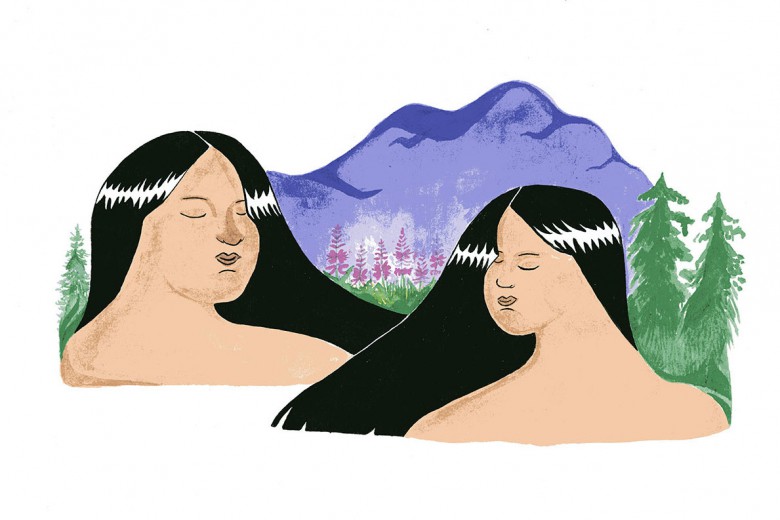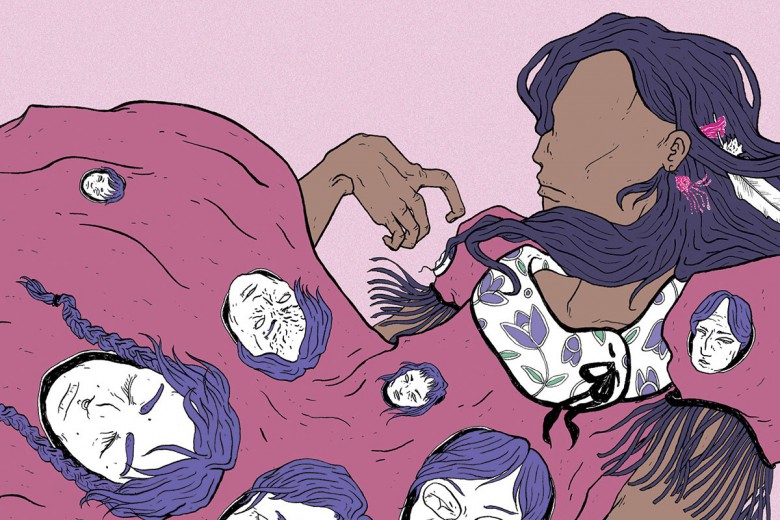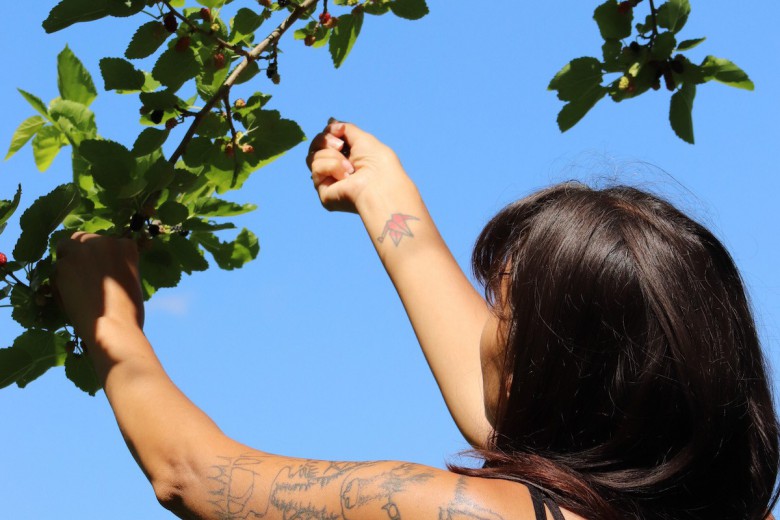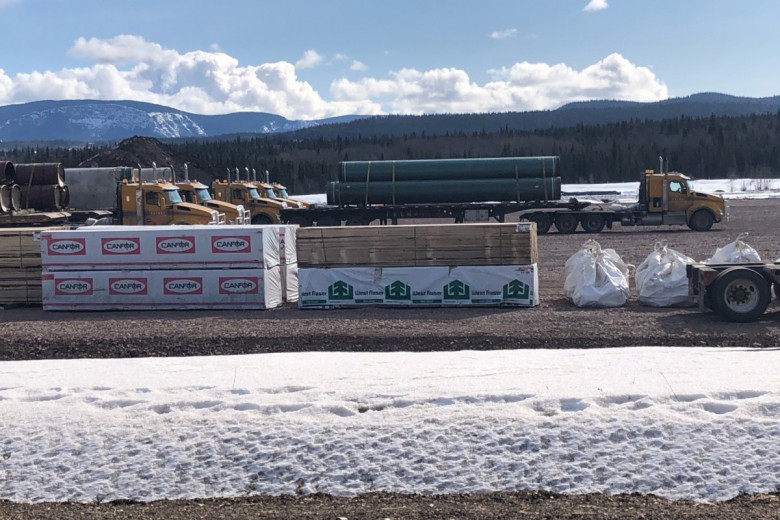Métis in Space is a podcast, so why tf are we doing Land Back?
Métis in Space is an Indigenous feminist science fiction podcast that, over the years, has evolved to encompass much more. While podcasting and Land Back might seem like wildly disparate projects, they are in fact closely related. We see our Land Back project, 2Land 2Furious, as a natural outgrowth of our work in Indigenous – and particularly Métis – futurisms. Métis futurisms, like Indigenous futurisms more broadly, resist the colonial narratives that Indigenous people don’t exist in the future and have no future; that we as peoples are disappearing and dying out; that we are unmodern and unmodernizable. Métis futurisms, which we build in the podcast by speaking back to colonial speculative fiction tropes and imagining decolonized futures, are intimately tied to the land. Land Back is Métis futurism in a very material sense – it’s how we build, remember, and reclaim our relationships with one another and the land, how we enact fundamental principles of Métis governance. When we take the land back we also take the future back from the colonizer. So Land Back means space for us to do the work of bringing those futures into being.
Land Back is Métis futurism in a very material sense – it’s how we build, remember, and reclaim our relationships with one another and the land, how we enact fundamental principles of Métis governance.
Two governance principles that underpin our work are wahkohtowin, or “being in relation with,” and kiyokêwin, or “visiting.” When we have guests on the podcast, we take care to host them in accordance with our responsibilities, which means spending time chatting around the kitchen table, going to karaoke, making and eating a good meal, and more. This contributes to building and maintaining strong relationships with our guests, who come from many different Indigenous Nations. 2Land 2Furious extends our relational responsibilities out of the urban centres we’ve lived in for the past six years in ways that prioritize our community and Indigenous governance on our lands.
How did we do the thing?
Challenging the concept of land as property by purchasing land under colonial property regimes is a troubling contradiction. Canada is a legal fiction based on the assertion of Crown sovereignty over all lands, but fictional or not, it’s backed up with militarized force and we have to take that into consideration. We looked at some other Land Back projects for guidance on this. A number of them exist on so-called Crown lands, and Indigenous Peoples asserting their rights to these lands exist within a complicated web of Canadian case law that is often misapplied and maliciously enforced. The best tactic in these situations has been constant physical presence on the land, so that state agents do not simply come in and bulldoze everything while you’re away. But we knew that we would not be able to mount that kind of occupation at this point in our lives.
Purchasing land in fee simple provides some of the strongest legal rights under colonial law and ensures some level of permanence so we can do long-term planning and building.
Another barrier to asserting our rights by squatting on Crown land is the fact that the traditional territories surrounding Edmonton are fairly densely populated and Crown land is heavily used. The likelihood of conflict with state forces and rural residents is heightened as a result, and we do not have the kind of resources necessary to mount an extended occupation in the face of this potential violence. We would be unable to protect anything we built, or store supplies, and we could not ensure the safety of the people who we want accessing the land.
Purchasing land in fee simple provides some of the strongest legal rights under colonial law and ensures some level of permanence so we can do long-term planning and building. We have seen a number of Land Back projects take this route, either by receiving gifts of land or raising funds to make purchases directly. Following the example of the Sogorea Te’ Land Trust, which “facilitates the return of Chochenyo and Karkin Ohlone lands in the San Francisco Bay Area to Indigenous stewardship,” we opted to create a land trust through the legal vehicle of a non-profit organization. This ensures that any deterioration in our personal financial situations would not endanger the land and force us to sell it off, precisely in the way many Métis were dispossessed of land. It also prevents any of us from personally profiting from the land. A land trust also allows us to create certain caveats for use of the land, which reduces its desirability for farmers and developers.
Settlers need to foot that bill, either by gifting land back or helping with the funds needed for Indigenous people to reclaim their lands!
We certainly could not afford to purchase land ourselves, and while we were able to hold our noses and dive into the fiction of land-as-property as a means to an end, there was no fucking way we were going to buy our own land back. Settlers need to foot that bill, either by gifting land back or helping with the funds needed for Indigenous people to reclaim their lands!
We began raising money, expecting a medium- to long-term timeline to having enough funds. However, within just a few weeks, a sugar settler contacted us from across the medicine line and offered to give us enough money to buy a quarter section. All of a sudden, things kicked into high gear: we contacted a real estate agent and a lawyer and then started looking for suitable land!
A quarter section of land is a whopping 160 acres and a common division in rural areas. Land prices vary greatly depending on the rural county. Lac Ste. Anne County, for example, is a much poorer area than Pembina County, which means it has lower land prices.
The first piece of land we saw was partially cleared for hay, partially wooded wetland, and the majority of a freshwater lake populated by ducks, geese, swans, and loons.
Even so, the way in which land is valued under settler colonialism rarely makes sense. Lac Ste. Anne County is an exercise in futility; there, farmlands were created from the destruction of ecologically important wetlands and muskeg. We discovered that land described as “mostly wooded” meant the land was predominantly untouched wetlands, bursting with biodiversity, and apparently extremely undesirable on the real estate market. Quite a few of the pieces of land we looked at had pipelines and gas installations on them, and the private security that accompanied them was an uneasy presence. Other areas abutted multi-use trails, and we were uncomfortable with the idea of settlers raging through on their ATVs.
The first piece of land we saw was partially cleared for hay, partially wooded wetland, and the majority of a freshwater lake populated by ducks, geese, swans, and loons. We saw signs of deer, elk, and moose. We walked through an area with low-bush cranberry, wild mint, and other food sources. We weren’t sure at the time that it was the perfect spot until we did a bit more looking, and circled back to this quarter section. Soon, we made an offer, and the sale went through!
Priorities: how do we get the land set up?
To have people out on the land, there are a few things we absolutely need to get set up. There is currently no road access into the land, so we have to hire someone to build us a driveway. We’ll have to pay to have a well dug for fresh water, because hauling water in for drinking, cooking, and washing would make it difficult to host visitors.
All of this is quite expensive, and we need to keep fundraising to cover the costs.
Before we can begin building anything even semi-permanently, we will need safe storage (most likely sea cans), so that the materials and supplies we bring out there aren’t stolen or destroyed; we are, after all, surrounded by white people. We will be able to squeak by for a while with outhouses, but composting toilets are a better sewage solution, and eventually we are going to need comprehensive sewage infrastructure. We’d hoped to get most of this done this year, but like with everything else, COVID has slowed our plans down considerably. All of this is quite expensive, and we need to keep fundraising to cover the costs.
What do we see the Land Back project doing?
We want our work with and on the land to be primarily relationship- and capacity-building, with a focus on research and cultural activities geared toward urban BIPOC in the neighbourhoods we live in – so-called “inner city” Edmonton. While we don’t yet know exactly what that will look like, we are committed to doing and facilitating this work in the spirit of solidarity- and community-building. The idea is not that we will run all, or even a majority, of the programming that occurs on the land – we both work full-time and have other obligations in addition to 2Land 2Furious, and neither of us are qualified to run ceremonies. But we recognize that access to land free from state and settler monitoring and constraints is a huge barrier to cultural engagement and knowledge-generation for many low-income urban folks.
When we were looking for land, we wanted (and found!) topographical diversity that could support a variety of interests and projects. We hope to engage with Indigenous scientists and Knowledge Keepers to do the work they are interested in, whether that looks like prairie biome rewilding, water revitalization research, traditional food systems work, ceremony, or language camps.
In our view, land governed in a good way through Métis governance is queer land.
Another thing we have committed to from the outset is centring LGBTQ2S+ people and youth in our work. Lac Ste. Anne County and surrounding areas have seen a surge of Christian evangelical organizations buying up tons of land, especially along lakes, for youth camps, retreats, and the like. For many people who have less access to non-urban spaces, these Christian groups might currently be the only way they are able to make it out of the city. Many of these groups are explicitly cisheterosupremacist, so it’s important to us that we create space – especially cultural and ceremonial space – that is supportive of and safer for queer, trans, and Two-Spirit youth, and also that we are not reliant on working with or engaging groups that hold repressive, colonial views on gender and sexuality. In our view, land governed in a good way through Métis governance is queer land.
What challenges did we face?
Comprehension has been a major challenge for this Land Back project. From the very beginning, we had difficulty getting people to understand what we were trying to do. Our real estate agent had never dealt with a land purchase like this, and the sellers were also curious about our plans. The banks were suspicious about such a large sum of money and the fact that it was coming from someone across the medicine line. The lawyer we hired had set up land trusts before, but nothing that focused on the kinds of cultural activities we want to organize around.
This led to some stressful moments. A lot of paperwork was needed, and we were worried this might scare off the donor, so we need people to be aware that this is not a simple process! Sending such large sums across the border meant we had to somehow pigeonhole our project into something comprehensible to the banks, and our difficulty with that almost kiboshed the deal, because they did not want to release the money in time for the sale to go through. To prevent the land sale from falling through, Chelsea had to leverage her credit card for a deposit, taking a major risk that the donor wasn’t just fooling around. Don’t do this, folks.
From the very beginning, we had difficulty getting people to understand what we were trying to do.
Even worse, we weren’t yet set up as a non-profit organization, so the contract for the sale was between Chelsea, personally, and the sellers, with a provision that as soon as the non-profit was incorporated, the land would be transferred to it. Despite repeatedly explaining the situation to the real estate agent and to our lawyer, something got missed, or wasn’t possible, and for 11 days Chelsea was personally on the hook to complete the purchase. This meant that if the donor pulled out, the seller could sue Chelsea and demand she come up with the purchase price! A significant number of our hairs turned grey over this. Thankfully, things worked out, but these pitfalls are very serious and need to be addressed if others want to start Land Back projects through similar mechanisms.
Another major challenge has been transportation. For example, Chelsea’s licence has expired, and she has no vehicle. We also know that transportation is a major barrier for a lot of inner city folks, so providing appropriate transportation is going to be an essential part of this project. Accessibility needs to be built in from the beginning – so, for example, that transportation will need to accommodate wheelchair users, and getting out onto the land has to be similarly accessible.
This meant that if the donor pulled out, the seller could sue Chelsea and demand she come up with the purchase price! A significant number of our hairs turned grey over this.
Obviously the pandemic has also created a number of challenges and slowed things down considerably. Our aspirations for Land Back outpace our availability, as we all have other obligations, so keeping things small and sustainable means taking the time to prioritize and plan beyond our lifetimes.
In addition, it is absolutely essential that we form good relationships with our neighbours, and like all relationships, that will require ongoing effort. Our safety depends on these relationships. A major reason we chose this particular piece of land is because it is not directly off the highway, so it is less visible to passersby, and there is a big section that is not visible to adjoining property owners.
Another challenge is backseat project management. Since we first began talking about embarking on this wild journey, everyone and their auntie seems to know best and has no problem telling us what we should be doing. Often these suggestions far outpace our actual capabilities, and sometimes they are outright contrary to the reclamation that we want to do.
What are the issues with Land Back?
Like with a lot of other opportunities Indigenous people have fought for over the years, there is always the issue of both outright settlers and pretendians (non-Indigenous people who pretend to be Indigenous) taking control of Land Back projects. There are already many settlers running land trusts who, in our opinion, could turn those trusts over to Indigenous control. Maintaining as much autonomy as possible throughout this process, and ensuring that the land trust remains in Métis hands (we are known as “les gens libres” and “the people who own themselves” for a reason!) have been strong priorities for us. Right now, that looks like ensuring that the state-mandated “directorship” of the project is composed of Métis we personally know and trust. This will allow us to take the time to develop a strong political and interpersonal culture for the project so that when we pass the land along, we know that it will be held with care. This is also a governance issue, as having Métis women and non-binary people making the controlling decisions and setting community standards is a reclamation and embodiment of what we want to see in Métis governance on a larger scale.
We can’t rely on state instruments to ensure the future of the land: it’s relationships, not the state, that will protect the land trust for future generations.
Another issue is the general reality that land ownership options are extremely limited under settler law. There is no land ownership scheme that is not subject to Crown expropriation and control. We can’t create independent micronations or declare our small piece of land liberated from settler meddling. No settler ownership schemes even begin to approximate Indigenous land ownership traditions, so our governance and care for the land will be always already constrained by the state, for as long as the state lasts (hopefully not that much longer). We can’t rely on state instruments to ensure the future of the land: it’s relationships, not the state, that will protect the land trust for future generations.
Another real problem that stems from settler land ownership schemes is that these schemes cannot account for the shared jurisdiction that characterizes much of traditional Indigenous landholding practices. There is also the issue of who gets to decide what happens to land when it is gifted to the nation or nations on whose territory it lies. When settlers want to give land back, who do they contact? State-recognized bodies like the Métis Nation of Alberta (MNA) headquarters … or a reserve band office? Often these organizations simply don’t have anyone they can dedicate to facilitating a Land Back process with individuals or non-state groups. In addition, as two women who find ourselves disagreeing with a lot of the politics and actions of our Nation’s governing institution, we frankly don’t want or need our land to be subject to the MNA’s control or policies, either. So we haven’t answered the question of who to contact to give the land back. One option we’ve been pondering is the establishment of a regional inter-Nation coalition, hearkening back to historical alliances like the nehiyaw-pwat, that would include not just state-recognized leadership but also other invested communities who could make decisions together to administrate Land Back lands in the best interest of all involved.
Conclusion
We have shared some of our processes and thoughts on 2Land 2Furious, but there is no one-size-fits-all Land Back playbook that will work for everyone, everywhere, all of the time. On private land, in cities, on the keemooch, on Crown lands, on reserve and settlement lands, Land Back is happening all over the place, and we are grateful to be able to join this collective work. Our ultimate goal is to once again hold and govern Indigenous lands without any Crown title; it would just be Indigenous Land. Land Back projects are strong assertions of Indigenous sovereignty wherever they are found, and we hope to continue to struggle with and learn from everyone doing this work in a good way.
How can you support the project?
To learn more about Back 2 The Land: 2Land 2Furious and to check out the Métis in Space podcast, see: www.metisinspace.com. To support the project, you can donate to our GoFundMe.


